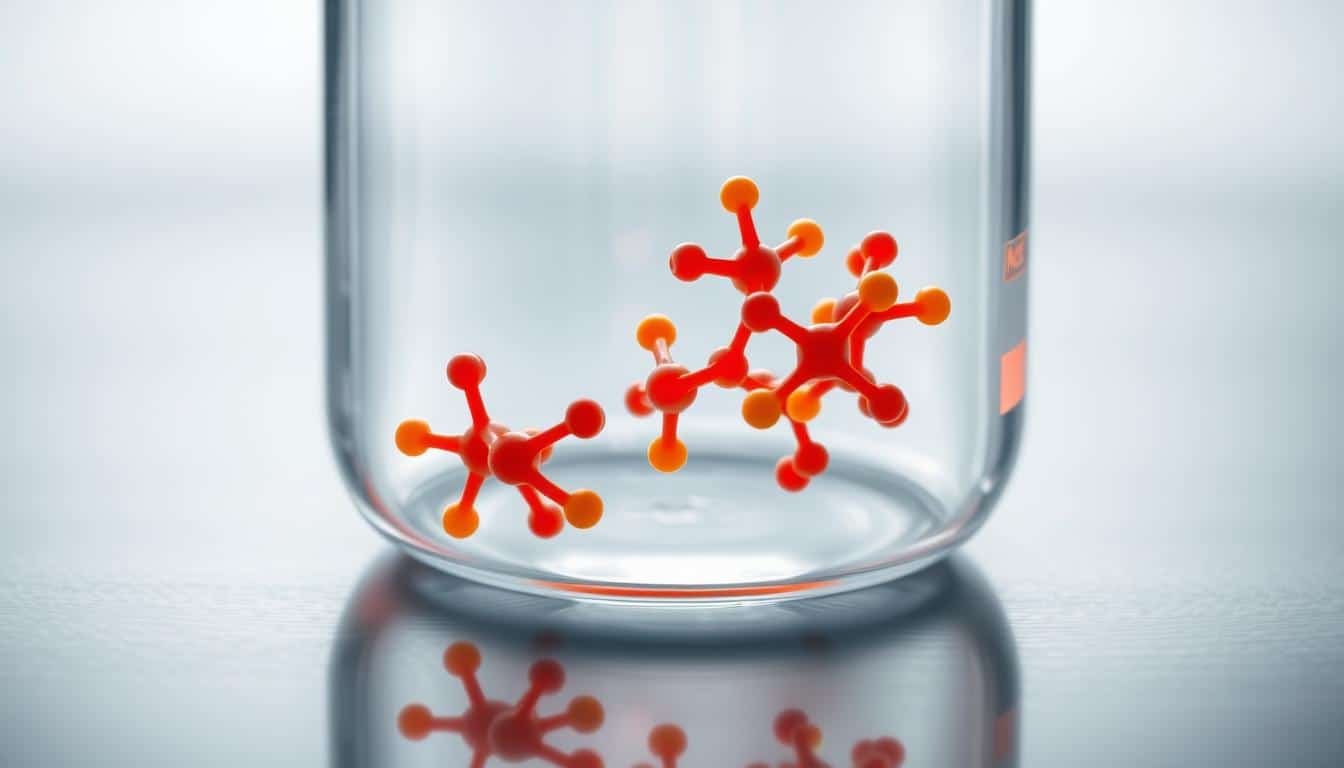Ever felt like your energy crashes during intense workouts? You’re not alone. Many athletes and fitness enthusiasts face this challenge. That’s where beta-alanine steps in. It’s a game-changer for those pushing their limits in short, high-effort activities like sprints or HIIT.
Research involving over 1,981 participants across 16 trials shows its effectiveness. This supplement helps you maintain strength and endurance, even during the final reps. Imagine finishing your last set as strong as your first—that’s the power of carnosine buffering.
Ready to take your performance to the next level? Let’s dive into how this works and why it’s a must-have for your fitness routine.
What Is Beta-Alanine?
Curious about the secret behind lasting energy in intense sessions? It’s all about beta-alanine, a natural amino acid your body uses to fight fatigue. Think of it as your internal shield against muscle burnout.

This powerhouse combines with histidine to form carnosine, a duo that’s like the special sauce in your workout burger. Carnosine helps regulate hydrogen ions, which build up during exercise and cause that burning sensation in your muscles.
Unlike other amino acids that focus on building muscle, beta-alanine is all about protection. It’s the unsung hero that keeps your muscles firing when you need them most. Meat-eaters have a natural edge here, as their diets naturally boost carnosine levels.
If you’re looking to enhance your performance, adding beta-alanine supplements to your routine can make a big difference. It’s like giving your body the tools it needs to stay strong, even when the going gets tough.
How Beta-Alanine Enhances High-Intensity Performance
Ever wondered how some athletes keep going when others hit a wall? The answer lies in carnosine, a natural compound that helps your muscles perform better under stress. Let’s break down how it works and why it’s a game-changer for your workouts.
The Role of Carnosine in Muscle Function
Think of carnosine as a chemical sponge. It soaks up the acid that builds up in your muscles during exercise. This acid, mostly hydrogen ions, is what causes that burning sensation when you’re pushing hard. Carnosine neutralizes it, allowing you to keep going.
Research shows that supplementing with beta-alanine can increase carnosine levels by 30-50%. This means less acid and more endurance. It’s like turning down the heat when your muscles are on fire.
Buffering Acid in Muscles During Exercise
When you’re lifting weights or sprinting, your body produces lactic acid. Contrary to popular belief, it’s not the milk! This acid lowers your muscle pH, making it harder to perform. Carnosine acts as a buffer, keeping your muscles in the optimal pH range.
For example, powerlifters often rely on this effect to push through their final reps. It’s what keeps them strong when others would give up. By reducing hydrogen ion accumulation, carnosine helps you maintain peak performance longer.
| Scenario | Acidity Reduction |
|---|---|
| Without Carnosine | High acidity, faster fatigue |
| With Carnosine | 30-50% less acidity, sustained energy |
Benefits of Beta-Alanine for High-Intensity Training
Want to push harder and last longer in your workouts? Beta-alanine can help you achieve just that. It’s not just about adding more time to your session—it’s about making every rep count.
Delaying Muscle Fatigue
Imagine hitting your 10th box jump with the same power as your first. That’s what beta-alanine can do. By reducing fatigue, it lets you squeeze out more quality reps. Studies show it can extend your training time by up to 18% before exhaustion sets in.
Think of it like car maintenance. A better pH balance in your muscles is like smoother engine performance. You’ll feel the difference in every move, whether you’re lifting weights or sprinting.
Improving Exercise Endurance
For those into interval training, beta-alanine is a game-changer. It helps you maintain intensity during high-intensity interval workouts. One study found a 14% improvement in wall ball shots—proof that it works for both strength and cardio enthusiasts.
Delayed fatigue means more energy for your final sets. It’s like having a secret weapon that keeps you going when others would stop. Whether you’re a gym regular or a pro athlete, the benefits are clear.
Beta-Alanine and Carnosine: A Powerful Combination
Looking for a way to supercharge your workouts? Beta-alanine and carnosine work together like a dream team. This dynamic duo helps you push harder, last longer, and recover faster. Let’s explore how they team up to take your performance to the next level.
How Beta-Alanine Increases Carnosine Levels
Think of beta-alanine as the delivery truck and carnosine as the construction crew. Beta-alanine trucks in the materials, while carnosine builds the buffer in your muscles. This process helps reduce fatigue and keeps you going strong.
Studies show that taking 4.8 grams of beta-alanine daily can boost carnosine levels by 60-80%. This is especially true for athletes like cyclists, who rely on endurance. The key? Consistency. It takes at least two weeks of supplementation to see noticeable changes.
The Impact of Carnosine on Athletic Performance
Carnosine is like a battery for your muscles. The more you have, the longer you can perform at your peak. It works by neutralizing acid buildup, which is what causes that burning sensation during intense exercise.
This effect not only helps improve exercise endurance but also provides an antioxidant bonus. Two benefits, one supplement. Whether you’re lifting weights or sprinting, higher carnosine levels mean better performance and faster recovery.
Optimal Dosage of Beta-Alanine
Struggling to find the right amount of beta-alanine for your workouts? You’re not alone. Getting the dose right can make all the difference in your performance. Let’s break it down so you can maximize your results without the guesswork.
Recommended Daily Intake
For most athletes, a daily dose of 1.2 grams is ideal for maintaining performance. This amount helps keep your carnosine levels steady, ensuring your muscles stay strong during intense sessions. Think of it as your daily fuel for peak performance.
If you’re just starting, you might notice a tingling sensation. This is normal and harmless. To avoid it, split your dose into smaller amounts throughout the day. For example, take 0.4 grams with breakfast, lunch, and dinner.
Loading Phase vs. Maintenance Phase
Want faster results? Start with a loading phase. Take 6.4 grams per day for 4 weeks. This is like carbo-loading before a marathon—it builds up your carnosine levels quickly. After this, switch to the maintenance dose of 1.2 grams daily.
Here’s a quick comparison to help you decide:
| Phase | Dose | Duration |
|---|---|---|
| Loading | 6.4 grams per day | 4 weeks |
| Maintenance | 1.2 grams per day | Ongoing |
For those with sensitive stomachs, veggie capsules are a great option. They’re gentle and effective, making it easier to stick to your supplement schedule.
Remember, consistency is key. Stick to your plan, and you’ll see the results in your performance.
Food Sources of Beta-Alanine
Looking to fuel your body naturally for better performance? Your diet plays a big role in how you feel and perform during workouts. Let’s explore the best food sources of beta-alanine and how they can support your fitness goals.
Animal-Based Sources
If you’re a meat-eater, you’re in luck. Animal products are packed with beta-alanine, making them a great way to boost your levels naturally. Here’s a quick grocery list of the top sources:
- Chicken breast: 0.8 grams per 3-ounce serving. Three servings equal one supplement dose.
- Beef: A 3-ounce steak provides about 0.7 grams.
- Pork: A similar serving size offers around 0.6 grams.
- Fish: Salmon and tuna are excellent options, with 0.5 grams per serving.
- Turkey: Another lean choice, delivering 0.4 grams per 3 ounces.
These sources not only fuel your workouts but also provide essential amino acids your body needs to recover and thrive.
Challenges for Vegetarians and Vegans
For plant-based athletes, getting enough beta-alanine can be trickier. Studies show vegetarians have 30% lower baseline levels compared to meat-eaters. But don’t worry—there are ways to bridge the gap.
Pairing histidine-rich foods like beans, lentils, and quinoa with beta-alanine supplements can improve synthesis. Think of it as a team effort to keep your body performing at its best.
While food sources are a great start, supplements can help ensure you’re getting enough. It’s like the difference between home cooking and takeout—both work, but one gives you more control over your intake.
Combining Beta-Alanine with Other Supplements
Ever thought about pairing your supplements for better results? When it comes to maximizing your performance, combining beta-alanine with other supplements can be a game-changer. Let’s explore how these duos work together to take your workouts to the next level.
Beta-Alanine and Creatine
Think of this combo as a car engine: beta-alanine cools, while creatine fuels. Together, they boost your power output by up to 12%. Studies show this synergy helps you push harder during intense sessions, whether you’re lifting weights or sprinting.
Timing matters here. Take beta-alanine in the morning to keep your muscles fresh throughout the day. Then, grab creatine post-workout to fuel recovery and growth. It’s a simple yet effective way to get the most out of both supplements.
Beta-Alanine and Sodium Bicarbonate
Pairing beta-alanine with sodium bicarbonate enhances your body’s buffering capacity. This means less fatigue and more endurance during high-effort activities. However, be prepared for a common side effect: the infamous “baking soda burps.”
To avoid discomfort, start with smaller doses and gradually increase. For example, take sodium bicarbonate 30 minutes before your workout and beta-alanine earlier in the day. This schedule ensures both effects kick in when you need them most.
Here’s a quick guide to stacking these supplements based on your workout type:
- Strength Training: Beta-alanine in the morning, creatine post-workout.
- Endurance Workouts: Sodium bicarbonate 30 minutes before, beta-alanine earlier in the day.
- HIIT Sessions: Combine all three for maximum performance.
By combining beta-alanine with the right partners, you’ll unlock new levels of strength, endurance, and recovery. It’s all about finding the perfect stack for your goals.
Potential Side Effects of Beta-Alanine
Noticing a tingling sensation after taking your pre-workout? You’re not alone. This is one of the most common side effects of beta-alanine, known as paresthesia. It’s like your muscles sending thank-you notes—a sign the supplement is working.
Research shows that 85% of users experience this tingling at doses of 3.2 grams or higher. The good news? It’s completely harmless and temporary. Think of it as your body’s way of adjusting, similar to how you build tolerance to caffeine over time.
Common Side Effects
Besides tingling, some users report mild flushing or a warm sensation. These effects are also short-lived and tend to fade as your body adapts. If you’re new to beta-alanine, these reactions are normal and nothing to worry about.
How to Minimize Side Effects
Want to reduce the tingling? Try the “divide and conquer” approach. Splitting your daily dose into smaller amounts can cut symptoms by 60%. For example, take 0.8 grams with breakfast, lunch, and dinner instead of one large dose.
Timing your intake with meals can also help. Food acts as a natural buffer, making the experience smoother. And if you’re still adjusting, remember—your body will adapt, just like it does with caffeine.
Research on Beta-Alanine and Exercise Performance
What does science say about enhancing your workout results? Let’s dive into the research to uncover how beta-alanine can support your fitness goals. From sprint times to safety, the evidence is compelling.
Key Findings from Clinical Studies
Eight meta-analyses confirm that beta-alanine is safe and effective for improving performance. These studies involved thousands of participants, showing consistent results. For example, controlled trials revealed a significant improvement in 200m sprint times.
While beta-alanine isn’t a magic solution for endurance athletes, it shines in short, high-intensity activities. The effect on muscle endurance and recovery is well-documented, making it a reliable choice for those pushing their limits.
Limitations and Future Research Directions
Despite the positive findings, there’s still more to explore. Long-term research on aging populations is needed to understand its broader applications. Ongoing trials are also investigating its potential for brain health, opening exciting new possibilities.
Remember, your body is unique. Personal experimentation can help you determine what works best for your body composition and fitness goals. Science provides the foundation, but your experience is the ultimate evidence.
Conclusion
Ready to take your training to the next level? With beta-alanine supplementation, you’re just four weeks away from stronger, more consistent reps. Start with a loading phase during your training cycles to maximize carnosine levels and see noticeable improvements in your exercise performance.
For vegetarians, supplementation is especially important to bridge the gap in natural sources. Pair it with a workout journal to track your progress and stay motivated. Seeing your gains on paper can be a powerful reminder of how far you’ve come.
Your muscles want this fuel. Give them what they need, and watch your performance soar. It’s time to make every rep count!


